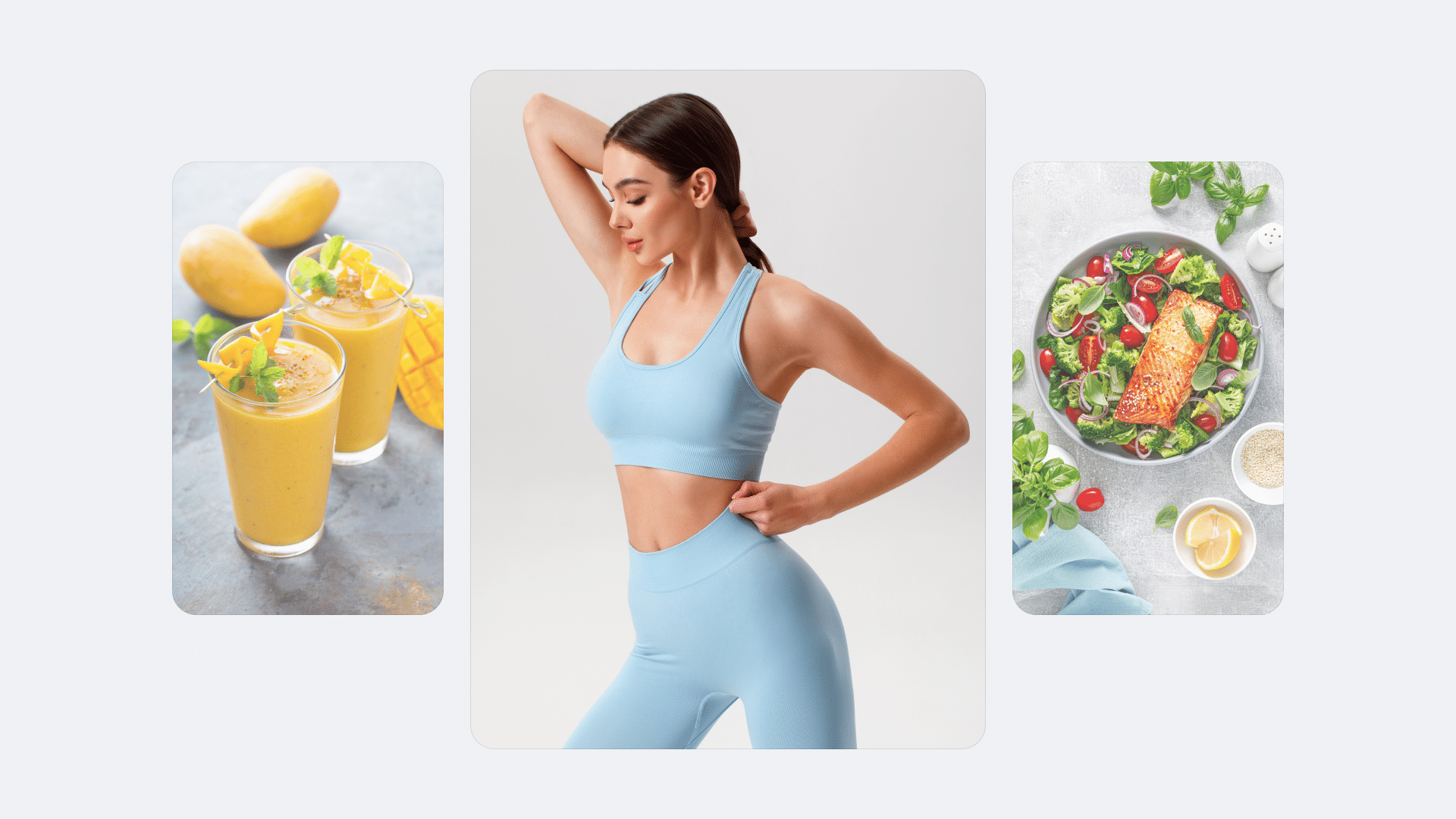The Benefits of Meal Plan Balance
Eating the right foods is essential for our busy lives. Good nutrition gives you energy, helps with weight control, and keeps you healthy. Your diet should match your level of physical activity to help you feel and perform at your best.
Understanding Nutritional Needs
Understanding your nutritional needs is the key to fueling your body for daily life. Think of your diet like a construction project – you need the right materials in the right amounts at the right time to complete the job.
Tailoring your nutrition to your activity level ensures you have the energy and nutrients required for optimal health. For nutrition, those materials are macronutrients and micronutrients.
Macronutrients and Their Importance
Macronutrients are the three types of nutrients your body needs in large amounts to function properly. They:
- Provide energy
- Support growth
- Help with development
- Help your body work as it should
The three macronutrients are carbohydrates, proteins, and fats.
Carbohydrates: Your Energy Source
Carbs are your body’s go-to source of energy. They come in two main forms: simple and complex.[1]
Simple Carbs:
- It is in foods such as candy, soda, and white bread.
- Give you a quick burst of energy that doesn’t last long.
- Okay in moderation.
- Eating too many can lead to energy crashes and other health problems.
Complex Carbs:
- Found in whole grains, fruits, and vegetables.
- Provide long-lasting energy and essential vitamins and minerals.
- They’re a better choice to fuel your body.
Proteins: Building Blocks
Proteins are like the Legos of your body. They help build and fix the parts of your body. You can find protein in many different food sources [2].
Good Sources of Protein:
- Lean meats
- Fish
- Eggs
- Dairy products
- Legumes (such as beans and lentils)
- Plant-based protein powders (such as pea and soy protein)
Types of Protein
Complete proteins are found in animal products and contain all the amino acids your body needs. Incomplete proteins that are found in plants are low in amino acids. Eating a variety of plant-based proteins can help ensure you get all the amino acids you need.
Betterme will keep you laser-focused on your weight loss journey! Nutrient-packed meal plans, fat-blasting workouts, galvanizing challenges and much more. Try using the app and see for yourself!
Fats: The Essential Helpers
Fats get a bad rap. However, they’re needed for your body to work right. They help make hormones and absorb vitamins [3]. There are four types of fats: saturated, monounsaturated, polyunsaturated, and trans.
Saturated fats:
- Found in foods such as butter and red meat
- Should be eaten in moderation
- Can increase your risk of heart disease
Monounsaturated fats:
- Found in foods such as avocados and olive oil
- May help lower cholesterol
- Reduces your risk of heart disease
Polyunsaturated fats:
- Found in foods such as fish and chia seeds
- Helps lower cholesterol
- Reduces your risk of heart disease
Trans fats:
- Found in processed foods such as baked goods and fried foods
- Raises cholesterol
- Increases your risk for chronic disease
Having the right mix of macronutrients in your diet is important for achieving good health. The ideal mix can vary depending on your needs and goals. The best advice is to talk to a physician or dietitian for personalized advice on achieving meal plan balance.
Micronutrients and Their Role
You know the saying: “Good things come in small packages.” This is true when it comes to micronutrients.
These tiny but mighty vitamins and minerals play a huge role in keeping your body running smoothly. You only need them in small amounts, but they’re just as important as the macronutrients everyone always talks about.
A diet that is lacking in micronutrients can lead to various health problems. Research has shown that poor development in children and increased vulnerability to disease are possible[4]. Ensuring you get enough micronutrients is essential for maintaining optimal health.
What Do Micronutrients Do?
Micronutrients support a whole bunch of your body’s functions, including:
- Energy production: They help turn food into fuel for your body.
- Growth and development: They’re essential for kids and teens, but adults need them too.
- Immune function: They help keep your body’s defense system strong.
- Heart health: They support your heart and keep your blood flowing smoothly.
Not getting enough micronutrients can lead to big problems, such as:
- Poor growth and development in kids and teens
- Weakened immune system
- Increased risk of diseases
- Fatigue and low energy
- Poor wound healing
Vitamins: Vital Functions
There are 13 vitamins your body needs. Here are some of the key players:
- Vitamin C: Supports immune function and wound healing. You can find it in foods such as citrus fruits and bell peppers.
- Folate (B9): Crucial for cell growth and development. You can find it in leafy greens and whole grains.
- Vitamin D: Supports bone health and immune function. Sources are fatty fish and sunlight.
Vitamins support [5]:
- Energy production
- Immune function
- Blood clotting
- Growth and development
Produce, whole grains, and lean proteins are rich in vitamins. Citrus fruits are high in vitamin C, which supports the immune system. Leafy greens such as spinach are rich in folate, a B vitamin that’s essential for cell growth [6].
Read more: A Beginner Intermittent Fasting Meal Plan To Fit Your IF Journey
Minerals: Key Elements
Minerals support heart health. They also build strong bones and promote healthy blood [7]. There are two types of minerals:
- Macrominerals: These are the ones you need a bit more of, including:
- Potassium: Helps support healthy blood pressure and heart function. Potassium sources include bananas and sweet potatoes[8].
- Calcium: Builds strong bones and teeth. You can find it in dairy and plant-based milk.
- Trace Minerals: You only need these in tiny amounts, but they’re still super important, and include:
- Iodine: Essential for thyroid function. Find it in iodized salt and seafood[9].
- Iron: Supports healthy red blood cells and prevents anemia. It’s in red meat and poultry.
Include a variety of produce, nuts, and whole grains in your diet to satisfy your mineral needs.
Getting Enough Micronutrients
A balanced diet is the best way to get the micronutrients your body needs. A diet should be filled with various whole foods, such as:
- Fruits
- Vegetables
- Whole grains
- Lean proteins
- Healthy fats
You may not get enough nutrients from food alone. Supplements can help fill in the gaps. Always talk to a healthcare provider before you start taking any new supplements. Ensuring you get enough nutrients is essential for maintaining optimal health and achieving a meal plan balance.
Tailoring Nutrition to Activity Levels
Proper nutrition is essential for maintaining overall health. Your diet should be adjusted based on your level of physical activity.
Your level of activity doesn’t matter, but understanding your specific nutritional needs can help optimize your well-being and performance. Your tailored nutrition to your activity level will ensure you have the energy and nutrients required to be your best self.
Sedentary Lifestyle: Nutritional Adjustments
You may sit for long periods without engaging in much physical activity, so you’ll need to be mindful of your diet. A balanced diet that doesn’t promote weight gain is the key.
A sedentary lifestyle is associated with numerous health risks, such as:
- Obesity
- Heart disease
- Diabetes
Regular check-ups with your doctor are important, particularly if you need to be more active. They help ensure you do what you can to maintain your health.
Caloric Needs
Sedentary individuals require fewer calories due to their lower energy expenditure. The recommended daily intake is 1,900 calories for sedentary women and 2,400 calories for sedentary men [10]. It’s important to stay within this range to maintain a healthy weight.
Nutrient Distribution
Focus on whole and nutritious foods such as:
- Vegetables: Aim for various colors to ensure intake of vitamins and minerals.
- Fruits: Choose fruits over juice or dried fruits for extra fiber benefits.
- Lean proteins: Include plant-based options such as beans and nuts.
- Whole grains: You can find fiber and vitamin B in brown rice and quinoa.
Limit processed and high-calorie foods. You should also avoid sugary drinks and saturated fats to maintain a healthy weight and prevent chronic diseases.
Moderately Active Lifestyle: Optimizing Intake
You’ll want to balance your activity levels and nutrition macronutrient intake if you engage in light physical activity or exercise for 1-3 days weekly. This will help better support your energy needs and overall health. This lifestyle includes people with jobs that require some physical effort and those who exercise lightly but regularly.
Balancing Macronutrients
You should aim for [11]:
- 30% of daily calories from protein: supports muscle mass and healing
- 20-30% of daily calories from fat: provides energy and promotes absorption of vitamins
- 40-50% of daily calories from carbs: the primary source of energy for the body
Enhancing Performance with Micronutrients
It’s important to pay attention to macronutrients and micronutrients. These include:
- Iron: crucial for transporting oxygen to muscles; include iron-rich foods such as lean meats, beans, and fortified cereals
- Calcium and vitamin D: support bone health; dairy, leafy greens, and fortified plant-based milk are excellent sources
- Antioxidants (vitamins C and E): help reduce muscle damage; nuts, seeds, and fruits are high in antioxidants
BetterMe app will kick you out of the mental funk, shake off your extra weight, rid you off your energy-zapping habits, and help you sculpt the body of your dreams. Intrigued? Hurry up and change your life for the better!
Highly Active Lifestyle: Maximizing Performance
Highly active people engage in strenuous exercise 4-6 days weekly. They may also be involved in a strenuous physical job. Both require a diet that supports energy production, performance, and recovery. Proper nutrition is the key to achieving athletic goals and preventing overtraining syndrome.
Increased Caloric Requirements
Caloric needs increase significantly:
- 2,400-3,000 calories/day for highly active women
- 3,000-3,500 calories/day for highly active men
- Possibly more for endurance athletes or those with incredibly high energy expenditure
Recovery and Nutrient Timing
Post-workout nutrition is very important:
- Consume a mix of carbs and protein within two hours of exercising to help with recovery [12].
- Aim for a 3:1 or 4:1 carb:protein ratio. Examples include a banana with peanut butter, chocolate milk, or an energy bar.
- Stay hydrated by drinking plenty of water with an aim to replace 150% of lost fluids.
Remember, everyone’s nutritional needs are slightly different. It’s always a good idea to speak with a doctor or dietitian to find the best diet plan for your specific needs and goals. They can help you create a personalized tailored nutrition plan based on your activity level and health status.
Creating a well-balanced meal plan that considers your activity level and nutritional needs is the key to maintaining optimal health and achieving your goals.
Creating a Balanced Meal Plan
A well-designed meal plan considers your individual nutritional needs and activity level. This guide will help you plan a nutritionally balanced meal that supports your overall health and well-being. Achieving meal plan balance is the key to maintaining optimal health and achieving your goals.
Whether you lead a sedentary lifestyle or are highly active, understanding your nutritional needs and tailoring your diet accordingly is essential. You can create a meal plan that supports your overall health and well-being by focusing on whole foods, balancing your macronutrient intake, and ensuring you get enough micronutrients.
Whether your goal is to maintain a healthy weight, support athletic performance, or simply feel your best, a well-balanced meal plan is the first step. So, take control of your health and start planning your nutritionally balanced meals today. Your body will thank you.
Assessing Personal Nutritional Needs
Before creating a meal plan, it’s important to understand your personal nutritional needs. This involves calculating your caloric requirements and determining the ideal ratios of carbohydrates, protein, and fat (macronutrients) for your diet.
Calculating Caloric Requirements
Your daily caloric needs are dependent on factors such as age and activity level. A safe and sustainable rate of weight loss is 1-2 pounds per week. This can be achieved by creating a daily caloric deficit of 500-1000 calories through diet and exercise [13].
Determining Macronutrient Ratios
The ideal macronutrient ratios for weight loss are [14]:
- Carbohydrates: 45-65% of daily calories
- Protein: 15-20% of daily calories
- Fat: 20-35% of daily calories
Sample Meal Plans for Different Activity Levels
Here are some examples of daily meal plans for low-activity and high-activity individuals. Portion sizes and snack frequency increase with activity level.
Low-Activity Meal Plan Example
- Breakfast: Overnight oats with banana and almond butter
- Lunch: Grilled chicken breast with quinoa and mixed vegetables
- Dinner: Baked salmon with sweet potato and green beans
- Snacks: Greek yogurt with berries and carrot sticks with hummus
High-Activity Meal Plan Example
- Breakfast: Avocado toast with scrambled eggs and cherry tomatoes
- Lunch: Turkey and avocado wrap with mixed greens
- Dinner: Grilled chicken breast with brown rice and steamed broccoli
- Snacks: Apple slices with peanut butter and a protein smoothie with banana and spinach
Remember: A balanced meal plan should include a variety of whole and unprocessed foods. The plan consists of lean proteins, complex carbohydrates, and healthy fats. You should avoid sugary drinks and limit your intake of saturated and trans fats [15].
Read more: Vegan Weight Loss Meal Plan and Prep Tips
FAQs
How should I adjust meal plans for changing activity levels?
Plan a nutritionally balanced meal to your nutrition that changes with your activity levels. Increase your calories if you become more active. Decrease them if you also want to reduce your caloric intake as you become less active.
What are common mistakes in meal planning?
Common mistakes include not eating enough and not staying hydrated. You should avoid fad diets and quick fixes. Instead, focus on sustainable lifestyle changes to plan a nutritionally balanced meal.
How can I ensure long-term adherence to a meal plan?
Plan by sticking to nutritionally balanced meal prepping and grocery shopping. Make healthy choices most of the time, but know that it’s okay to have an occasional indulgence. Seek support from a registered dietitian or nutritionist.
The Bottom Line
A well-balanced meal plan with nutrition that is tailored to your activity level can boost energy. It also supports weight management and overall health. By understanding your nutritional needs, you can optimize your performance and well-being.
Remember to stay consistent, be flexible, and make adjustments as needed. With time and patience, you can develop healthy habits that will last a lifetime.
DISCLAIMER:
This article is intended for general informational purposes only and does not serve to address individual circumstances. It is not a substitute for professional advice or help and should not be relied on for making any kind of decision-making. Any action taken as a direct or indirect result of the information in this article is entirely at your own risk and is your sole responsibility.
BetterMe, its content staff, and its medical advisors accept no responsibility for inaccuracies, errors, misstatements, inconsistencies, or omissions and specifically disclaim any liability, loss or risk, personal, professional or otherwise, which may be incurred as a consequence, directly or indirectly, of the use and/or application of any content.
You should always seek the advice of your physician or other qualified health provider with any questions you may have regarding a medical condition or your specific situation. Never disregard professional medical advice or delay seeking it because of BetterMe content. If you suspect or think you may have a medical emergency, call your doctor.
SOURCES:
- Grains (2024, https://www.myplate.gov/eat-healthy/grains#:~:text=Health%20Benefits,-All%20food%20and&text=Eating%20whole%20grains%20as%20part,may%20help%20with%20weight%20management.)
- Amino acids (2023, https://medlineplus.gov/ency/article/002222.htm)
- Healthy Eating (2024, https://www.heart.org/en/healthy-living/healthy-eating)
- Micronutrient Deficiency (2017, https://ourworldindata.org/micronutrient-deficiency)
- Vitamins (2023, https://nutritionsource.hsph.harvard.edu/folic-acid/)
- Folate (Folic Acid)-Vitamin B9 (2024, https://nutritionsource.hsph.harvard.edu/folic-acid/)
- Minerals (2024, https://medlineplus.gov/minerals.html)
- Potassium (2024, https://medlineplus.gov/potassium.html)
- Iodine (2024, https://ods.od.nih.gov/factsheets/Iodine-Consumer/#:~:text=Iodine%20is%20a%20mineral%20found,development%20during%20pregnancy%20and%20infancy.)
- Dietary Guidelines for Americans (2020, https://www.dietaryguidelines.gov/resources/2020-2025-dietary-guidelines-online-materials)
- Know Your Macros-Why Macronutrients are Key to Healthy Eating (2022, https://www.cedars-sinai.org/blog/what-are-macronutrients.html)
- Maximizing Muscle Recovery: The Role of Post-Workout Nutrition (2023, (https://www.rupahealth.com/post/maximizing-muscle-recovery-the-role-of-post-workout-nutrition)
- Calorie counting made easy (2024, https://www.health.harvard.edu/staying-healthy/calorie-counting-made-easy)
- The Best Macronutrient Ratio for Weight Loss (2022, https://www.medicinenet.com/the_best_macronutrient_ratio_for_weight_loss/article.htm)
- The American Heart Association Diet and Lifestyle Recommendations (2021, https://www.heart.org/en/healthy-living/healthy-eating/eat-smart/nutrition-basics/aha-diet-and-lifestyle-recommendations)











